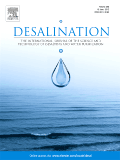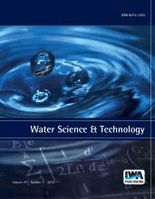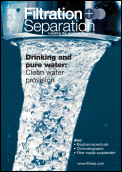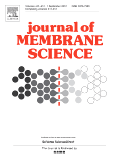
DESALINATION
Scope & Guideline
Empowering researchers to tackle global water scarcity challenges.
Introduction
Aims and Scopes
- Desalination Technologies:
The journal extensively covers various desalination methods such as reverse osmosis, membrane distillation, forward osmosis, and capacitive deionization, exploring their efficiencies, advancements, and applications. - Water Quality Improvement:
Research articles focus on enhancing water quality through innovative filtration and treatment technologies, addressing issues such as membrane fouling, scaling, and biofouling. - Resource Recovery:
The journal emphasizes the recovery of valuable resources from desalination brines and wastewater, including lithium and other critical minerals, highlighting sustainable practices. - Energy Efficiency:
Studies on optimizing energy consumption in desalination processes are prevalent, with a focus on integrating renewable energy sources and improving operational efficiencies. - Environmental Impact Assessments:
Research on the environmental implications of desalination technologies, including life cycle assessments and impacts on ecosystems, is a significant area of focus. - Innovative Materials and Membrane Technologies:
The development and application of novel materials for membrane fabrication, including nanomaterials and hybrid structures, are central to the journal's scope. - Modeling and Simulation:
The journal includes theoretical and computational studies that model desalination processes, helping to predict performance and optimize designs.
Trending and Emerging
- Advanced Hybrid Systems:
There is a growing focus on hybrid desalination systems that combine multiple technologies, such as integrating reverse osmosis with forward osmosis or membrane distillation, to enhance efficiency and resource recovery. - Nanomaterial Integration:
The use of nanomaterials in membrane fabrication and treatment processes is trending, with research focusing on their potential to improve performance, reduce fouling, and enhance durability. - Sustainable Resource Recovery:
Emerging research emphasizes the sustainable recovery of valuable resources from brine and wastewater, particularly lithium and other critical minerals, in line with circular economy principles. - Machine Learning and AI Applications:
The application of machine learning and AI for optimizing desalination processes and predicting performance outcomes is gaining traction, reflecting a shift towards data-driven approaches. - Environmental Sustainability Assessments:
An increasing number of studies are focusing on the environmental impacts of desalination processes, including life cycle assessments and ecological effects, as sustainability becomes a central concern. - Smart and Autonomous Systems:
The trend towards smart desalination technologies, including remote monitoring and automation, is becoming more prominent, addressing the need for efficient and responsive water management solutions. - Thermal and Phase Change Materials:
Research into thermal desalination processes and the use of phase change materials for energy efficiency improvements is on the rise, reflecting a renewed interest in thermally-driven technologies.
Declining or Waning
- Traditional Methods of Desalination:
There has been a noticeable decrease in research focused on conventional desalination methods without innovative enhancements, as the field shifts towards more advanced and efficient technologies. - Single-Focus Studies on Membrane Types:
Research that concentrates solely on specific types of membranes without addressing broader applications or integrations has become less common, as the focus has shifted to multifunctional and hybrid systems. - Static Analysis of Desalination Systems:
The trend is moving away from static analyses of desalination systems towards dynamic, real-time modeling and optimization, reflecting a need for more adaptive and efficient solutions. - Basic Water Treatment Techniques:
Basic water treatment methods that do not integrate advanced technologies or novel materials are featured less frequently, as the field progresses towards more complex and innovative solutions.
Similar Journals

WATER SCIENCE AND TECHNOLOGY
Connecting knowledge and technology for sustainable water practices.WATER SCIENCE AND TECHNOLOGY, published by IWA PUBLISHING, is a leading academic journal dedicated to advancing the field of water science and technology. With a rich history dating back to 1970, the journal provides a platform for innovative research and technological advancements, catering to the vital challenges faced within the realms of environmental engineering and water resource management. As evidenced by its strong ranking in Scopus, where it holds a position of #86 in Water Science and Technology and #77 in Environmental Engineering, the journal exemplifies significant scholarly contributions, reflected in its Q2 quartile status in both categories as of 2023. Although not an open access journal, WATER SCIENCE AND TECHNOLOGY ensures that its articles are widely available to researchers, professionals, and students passionate about sustainable water solutions. With a continued commitment to excellence, this journal plays a crucial role in shaping the discourse surrounding water quality, conservation, and technology innovation, making it an essential resource for all stakeholders in this critical field.

Desalination and Water Treatment
Exploring Sustainable Desalination TechniquesDesalination and Water Treatment is a pivotal journal in the realm of water science and technology, focusing on the critical issues surrounding water desalination and treatment processes. Published by DESALINATION PUBL in the United States, this journal, with ISSN 1944-3994 and E-ISSN 1944-3986, serves as an essential resource for researchers, professionals, and students engaged in ocean engineering, pollution control, and innovative water management strategies. With a transitional coverage from 2009 to 2024, it holds a respectable position in the third quartile of various categories, including Ocean Engineering, Pollution, and Water Science and Technology, as of 2023. The journal is indexed in Scopus, reflecting its contribution to the field by ranking within the 39th to 45th percentile across relevant subject areas. Although not an open-access publication, it remains a crucial platform for disseminating influential research, thereby enhancing the global repository of knowledge on water treatment methodologies and sustainable practices in desalination.

Asian Journal of Water Environment and Pollution
Fostering impactful discussions on water pollution management.Asian Journal of Water Environment and Pollution is a leading academic journal published by IOS PRESS, dedicated to advancing the field of water science and technology, as well as pollution management. With its ISSN 0972-9860 and E-ISSN 1875-8568, this journal serves as a pivotal platform for researchers, professionals, and academics alike who are keen to explore innovative solutions and interdisciplinary approaches toward water-related challenges and environmental issues. Although currently positioned in the Q4 category for both pollution and water science & technology, the journal aims to foster impactful research and discussions that can enhance the understanding and treatment of water pollution. The Asian Journal of Water Environment and Pollution not only plays a crucial role in disseminating knowledge but also encourages the sharing of findings from unique geographic perspectives, particularly from Asia. As the field evolves, this journal is poised to become a vital resource for those looking to contribute to sustainable water management practices and pollution reduction strategies.

npj Clean Water
Championing global collaboration for water quality.npj Clean Water, published by NATURE PORTFOLIO, is a premier open-access journal dedicated to advancing the field of water science and technology. Since its launch in 2018, this innovative publication has quickly established itself as a leading platform for original research and policy discussions concerning clean water access and quality. With an impressive impact factor and categorized in the Q1 Quartile across multiple environmental science disciplines—including management, monitoring, pollution, and waste management—npj Clean Water stands out for its rigorous peer-review process and commitment to disseminating high-quality research. Researchers, professionals, and students involved in water-related challenges will find invaluable insights that address critical environmental issues and promote sustainable practices. Access to articles is freely available, encouraging global collaboration and knowledge sharing within the water sector. This journal embodies a significant step towards achieving innovation and policy advancements in the pursuit of a cleaner, safer water future.

Journal of Water Process Engineering
Uniting Expertise in Water Process Engineering and BiotechnologyJournal of Water Process Engineering, published by Elsevier, stands as a leading authority in the interdisciplinary fields of Biotechnology, Process Chemistry and Technology, and Water Science and Technology. With its ISSN 2214-7144, this journal has established itself since its inception in 2014, reaching its convergence year in 2024. Renowned for its high-impact contributions, it holds a prestigious Q1 ranking in 2023 across multiple categories, including Safety, Risk, Reliability and Quality and Waste Management and Disposal. The journal aims to advance knowledge and practice in water processing, addressing global challenges related to water scarcity, environmental safety, and sustainable technology. While the journal does not currently offer open access options, it remains a vital resource for researchers, professionals, and students dedicated to advancing water process engineering and management practices. By disseminating innovative research and methodologies, the Journal of Water Process Engineering plays a crucial role in shaping future technologies and strategies essential for water sustainability.

International Journal of Environmental Science and Technology
Exploring innovative pathways in environmental science.International Journal of Environmental Science and Technology, published by SPRINGER, stands as a premier platform for the dissemination of cutting-edge research in the fields of environmental science, technology, and engineering. With an impressive scope spanning from 2005 to 2024, this journal serves as a vital resource for academic and professional communities engaged in tackling pressing environmental challenges. It boasts a strong reputation, evidenced by its Q1 ranking in Agricultural and Biological Sciences and solid placements in Environmental Chemistry and Engineering. Researchers searching for high-impact studies will find the journal's contributions significant, as reflected in its rankings within Scopus: 34th percentile in Agricultural and Biological Sciences and notable standings in Environmental Engineering and Chemistry. Although the journal is not currently an Open Access resource, it maintains a commitment to academic rigor and innovation, making it indispensable for those devoted to advancing knowledge in environmental sustainability and technology.

Filtration + Separation
Navigating Trends in Filtration Technology and SustainabilityFiltration + Separation is a distinguished journal published by MA HEALTHCARE LTD, specializing in the fields of filtration technology, separation processes, and their applications within environmental science and industrial engineering. With a commitment to advancing knowledge in these critical areas, this journal, established in 1970, has consistently provided a platform for innovative research and developments, catering to the unique challenges of the filtration and separation industry. Despite its recent categorization in the Q4 quartile across various fields, including Environmental Science and Industrial Engineering, it remains pivotal for researchers and professionals seeking to stay abreast of emerging trends and technologies. The journal is accessible through traditional subscription models and aims to bridge the gap between academic research and practical applications. As the industry evolves, Filtration + Separation continues to serve as an invaluable resource for both seasoned experts and budding scholars passionate about enhancing separation processes and environmental sustainability.

JOURNAL OF MEMBRANE SCIENCE
Unleashing Breakthroughs in Separation ProcessesJOURNAL OF MEMBRANE SCIENCE, published by Elsevier, is a premier academic journal dedicated to advancing the field of membrane technology and its applications in various scientific domains. With its ISSN 0376-7388 and E-ISSN 1873-3123, this journal is recognized for its significant contributions to the study of filtration, separation processes, and materials science. As of 2023, it boasts an outstanding impact factor, ranking in the Q1 quartile across several categories including Biochemistry, Filtration and Separation, and Physical and Theoretical Chemistry, making it a leading resource in these fields. Researchers benefit from its rigorous peer-review process and the inclusion of breakthrough research, critical reviews, and cutting-edge developments. With converged years spanning from 1976 to 2025, the JOURNAL OF MEMBRANE SCIENCE stands out as an essential platform for professionals, students, and academics eager to explore innovative solutions and findings in membrane science. Although it operates under a traditional access model, its wealth of knowledge and global reach ensure that it remains an indispensable asset for anyone engaged in this dynamic area of study.

SEPARATION AND PURIFICATION TECHNOLOGY
Advancing the frontiers of separation science.SEPARATION AND PURIFICATION TECHNOLOGY is a leading multidisciplinary journal published by Elsevier, focused on advancing the fields of Analytical Chemistry and Filtration and Separation. With its ISSN 1383-5866 and E-ISSN 1873-3794, this prestigious journal has achieved remarkable recognition, ranking in the top quartile (Q1) in both its categories, reflecting its substantial impact and relevance in the scientific community. Operating from its headquarters in Amsterdam, Netherlands, SEPARATION AND PURIFICATION TECHNOLOGY serves as a vital platform for researchers, professionals, and students to disseminate innovative findings and methodologies related to separation processes and purification techniques. The journal not only promotes open access research but also maintains a rigorous peer-review process to ensure high-quality publications. With a convergence period spanning from 1997 to 2025, it highlights the ongoing evolution and importance of separation technology in various applications, establishing it as an essential resource for those interested in cutting-edge advancements in analytical and chemical engineering domains.

ENVIRONMENTAL ENGINEERING SCIENCE
Empowering research that shapes environmental practices.ENVIRONMENTAL ENGINEERING SCIENCE is a leading journal published by MARY ANN LIEBERT, INC that provides a platform for pioneering research in the fields of environmental chemistry, pollution control, and waste management. With an ISSN of 1092-8758 and an E-ISSN of 1557-9018, this peer-reviewed journal aims to disseminate high-quality scientific studies that address critical environmental challenges. As evidenced by its 2023 category quartile rankings, it holds a notable position at Q3 in Environmental Chemistry and Pollution and Q2 in Waste Management and Disposal, highlighting its relevance and impact in these domains. Spanning over two decades from 1997 to 2024, the journal is dedicated to fostering innovations and promoting rigorous scholarship that can contribute significantly to sustainable environmental practices globally. Authors and researchers are encouraged to engage with this essential resource, which offers Open Access options to enhance the visibility and reach of their work. For those interested in advancing their understanding and practice within the environmental sciences, ENVIRONMENTAL ENGINEERING SCIENCE is an indispensable journal to consider.